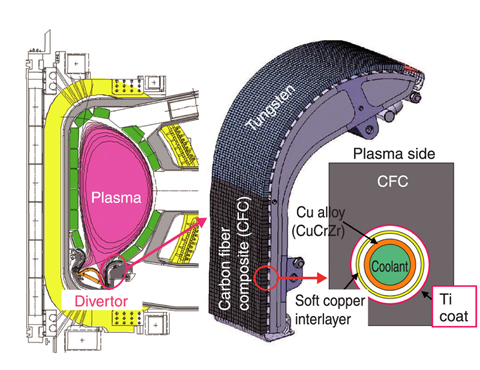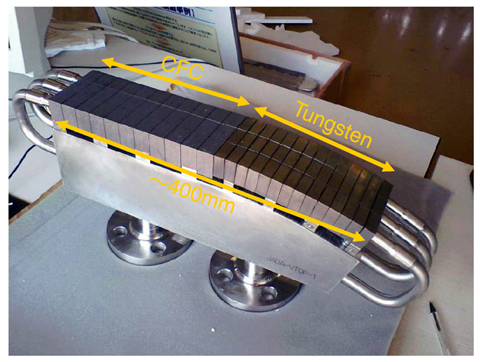
Fig.3-21 ITER divertor outer target

Fig.3-22 ITER divertor prototype
We have been performing R&D for the divertor, one of the in-vessel components of ITER (Fig.3-21). As a preliminary step toward providing divertors for actual use, we have fabricated divertor qualification prototypes in close collaboration with Japanese companies, and they have successfully passed high heat flux tests by ITER Organization (Fig.3-22). It is necessary for the ITER divertor to withstand repetitive heat flux of 20MW/m2 which no engineering devices have withstood up to now. To achieve robust components, we selected carbon fiber composites with higher thermal conductivity than pure copper as an armor material. The armor material is directly brazed onto a cooling tube to achieve sufficient heat removal capability.
However, it is difficult to braze armor materials with low thermal expansion coefficient onto copper alloy cooling tube. To overcome this, it is necessary to precisely control the assembly interface between the armor materials and the cooling tube. as a result of the R&D done in the engineering design phase of ITER, the armor materials and the copper alloy cooling tube have been brazed together with a soft copper interlayer to absorb the mismatch of their thermal expansion. In addition, the quality of the braze joint has been improved by applying Ti onto the carbon armor. This metallization process enables precise assembly accuracy of ±5μm.
Using the brazing technology above, we fabricated divertor prototypes. High heat flux tests were carried out at the Efremov institute in Russia under the supervision of ITER Organization. It was determined that the prototype could withstand heat flux of 20MW/m2 for 1000 cycles which is a criterion for the ITER divertor. Thus, we are the first of the Partners (EU and Russia) whose diverter has been certified by ITER Organization as qualified to start supplying divertors for ITER.
In 2009, we are going to start the fabrication of a divertor full-scale prototype as a first step in providing divertors for ITER. After that, we are going to start quantity production of divertor components and deliver them to the ITER site by around 2011.